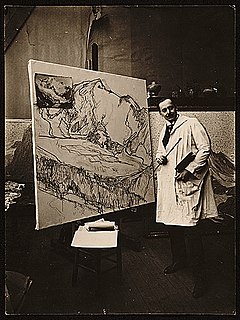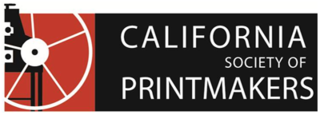Related Research Articles

Richard Diebenkorn was an American painter and printmaker. His early work is associated with abstract expressionism and the Bay Area Figurative Movement of the 1950s and 1960s. In the late 1960s he began his extensive series of geometric, lyrical abstract paintings. Known as the Ocean Park paintings, these paintings were instrumental to his achievement of worldwide acclaim.

Edgar Alwin Payne was an American painter. He was known as a Western landscape painter and muralist.

Xavier Martínez was a California artist active in the late 19th and early 20th century. He was a well-known bohemian figure in San Francisco, the East Bay, and the Monterey Peninsula and one of the co-founders of two California artists' organizations and an art gallery. He painted in a tonalist style and also produced monotypes, etchings, and silverpoint.
Henry Percy Gray (1869–1952) was an American painter. Gray was born on October 3, 1869 into a San Francisco family with broad literary and artistic tastes. He studied at the San Francisco School of Design and later under William Merritt Chase in New York. While he had some early Impressionistic tendencies, his basic approach to composition and color was derived from the Barbizon School and Tonalism, which were emphasized at the School of Design. He is primarily known for his romantic and lush depictions of the Northern California landscape.
Armin Hansen (1886–1957), a native of San Francisco, was a prominent American painter of the en plein air school, best known for his marine canvases. His father Herman Wendelborg Hansen was also a famous artist of the American West. The younger Hansen studied at the California School of Design in the Mark Hopkins Institute of Art and in Europe. He achieved international recognition for his scenes depicting men and the sea off the northern coast of California. He was elected an Associate to the National Academy of Design in 1926 and an Academician in 1948.

Nathan Oliveira was an American painter, printmaker, and sculptor, born in Oakland, California to immigrant Portuguese parents. Since the late 1950s, Oliveira has been the subject of nearly one hundred solo exhibitions, in addition to having been included in hundreds of group exhibitions in important museums and galleries worldwide. He taught studio art for several decades in California, beginning in the early 1950s, when he taught at the California College of Arts and Crafts in Oakland. After serving as a Visiting Artist at several universities, he became a Professor of Studio Art at Stanford University.

Soren Emil Carlsen was an American Impressionist painter who emigrated to the United States from Denmark. He became known for his still lifes. Later in his career, Carlsen expanded his range of subjects to include landscapes and seascapes as well.

Joe Goode is an American artist. He was born in Oklahoma City, Oklahoma, in 1937. In 1959 he moved to Los Angeles, California, where he attended the Chouinard Art Institute until 1961.

Ambrose McCarthy Patterson was a painter and printmaker.

William Frederic Ritschel, also known as Wilhelm Frederick Ritschel (1864–1949), was a California impressionist painter who was born in Nuremberg, Germany on July 11, 1864.

The California Society of Printmakers (CSP) is the oldest continuously operating association of printmakers and friends of printmakers in the United States. CSP is a non-profit arts organization with an international membership of print artists and supporters of the art of fine printmaking. CSP promotes professional development and opportunity for printmakers, and educates artists and the public about printmaking. New members are admitted by portfolio review. Friends, Institutional and Business members are admitted by fee. CSP is based in the San Francisco Bay Area, California.

Robert H. Hudson is an American visual artist. He is known for his funk art assemblage metal sculptures, but he has also worked in painting and printmaking.

Hermann Rosse was a Dutch-American architect, painter, theatrical designer, and art director. He won an Academy Award for Best Art Direction for the film the King of Jazz.
The San Francisco Art Association (SFAA) was an organization that promoted California artists, held art exhibitions, published a periodical, and established the first art school west of Chicago. The SFAA – which, by 1961, completed a long sequence of mission shifts and re-namings to become the San Francisco Art Institute – was the predecessor of the San Francisco Museum of Modern Art. Over its lifetime, the association helped establish a Northern California regional flavor of California Tonalism as differentiated from Southern California American Impressionism.
Maxwell Hendler is an American painter. In 1975, he became the first contemporary artist to have pictures in the collection of the Metropolitan Museum of Art in New York.

Arthur Putnam was an American sculptor and animalier who was recognized for his bronze sculptures of wild animals. Some of his artworks are public monuments. He was a well-known figure, both statewide and nationally, during the time he lived in California. Putnam was regarded as an artistic genius in San Francisco and his life was chronicled in the San Francisco and East Bay newspapers. He won a gold medal at the 1915 San Francisco world's fair, officially known as the Panama-Pacific International Exposition, and was responsible for large sculptural works that stand in San Francisco and San Diego. Putnam exhibited at the Armory Show in 1913, and his works were also exhibited in New York, Philadelphia, Chicago, Paris, and Rome.
Gottardo Fidele Piazzoni (1872–1945) was a Swiss-born American landscape painter, muralist and sculptor of Italian heritage, a key member of the school of Northern California artists in the early 1900s.

Pedro Joseph de Lemos was an American painter, printmaker, architect, illustrator, writer, lecturer, museum director and art educator in the San Francisco Bay Area. Prior to about 1930 he used the simpler name Pedro Lemos or Pedro J. Lemos; between 1931 and 1933 he changed the family name to de Lemos, believing that he was related to the Count de Lemos (1576–1622), patron of Miguel de Cervantes. Much of his work was influenced by traditional Japanese woodblock printing and the Arts and Crafts Movement. He became prominent in the field of art education, and he designed several unusual buildings in Palo Alto and Carmel-by-the-Sea, California.
Robert Boardman Howard (1896–1983), was a prominent American artist active in Northern California in the first half of the twentieth century. He is also known as Robert Howard, Robert B. Howard and Bob Howard. Howard was celebrated for his graphic art, watercolors, oils, and murals, as well as his Art Deco bas-reliefs and his "Modernist" sculptures and mobiles.
Ralph Helm Johonnot (1880–1940) was an American artist, designer, and arts educator, he is known for his educational series on color and interior decoration. He created paintings and prints, within the Arts and Crafts movement of still life and landscapes, as well as creating decorative work with his wife Salome Lavinia Johonnot. Together with Salome, they traveled to give educational lectures on the arts and created two private art schools, the Ralph Johonnot Studio in Richmond, California and Johonnot Summer School of Design and Hand Work in Pacific Grove, California. He was active in the arts throughout the state of California from approximately 1912–1940.
References
- 1 2 Robert B. Harshe. Dictionary of Art Historians. Retrieved May 8, 2014.
- ↑ "A Reader's Guide to Modern Art (1914)". San Francisco Public Library arts blog. 4 February 2014. Retrieved 12 June 2014.
- ↑ Robert B. Harshe Papers. Art Institute of Chicago. Retrieved May 8, 2014.